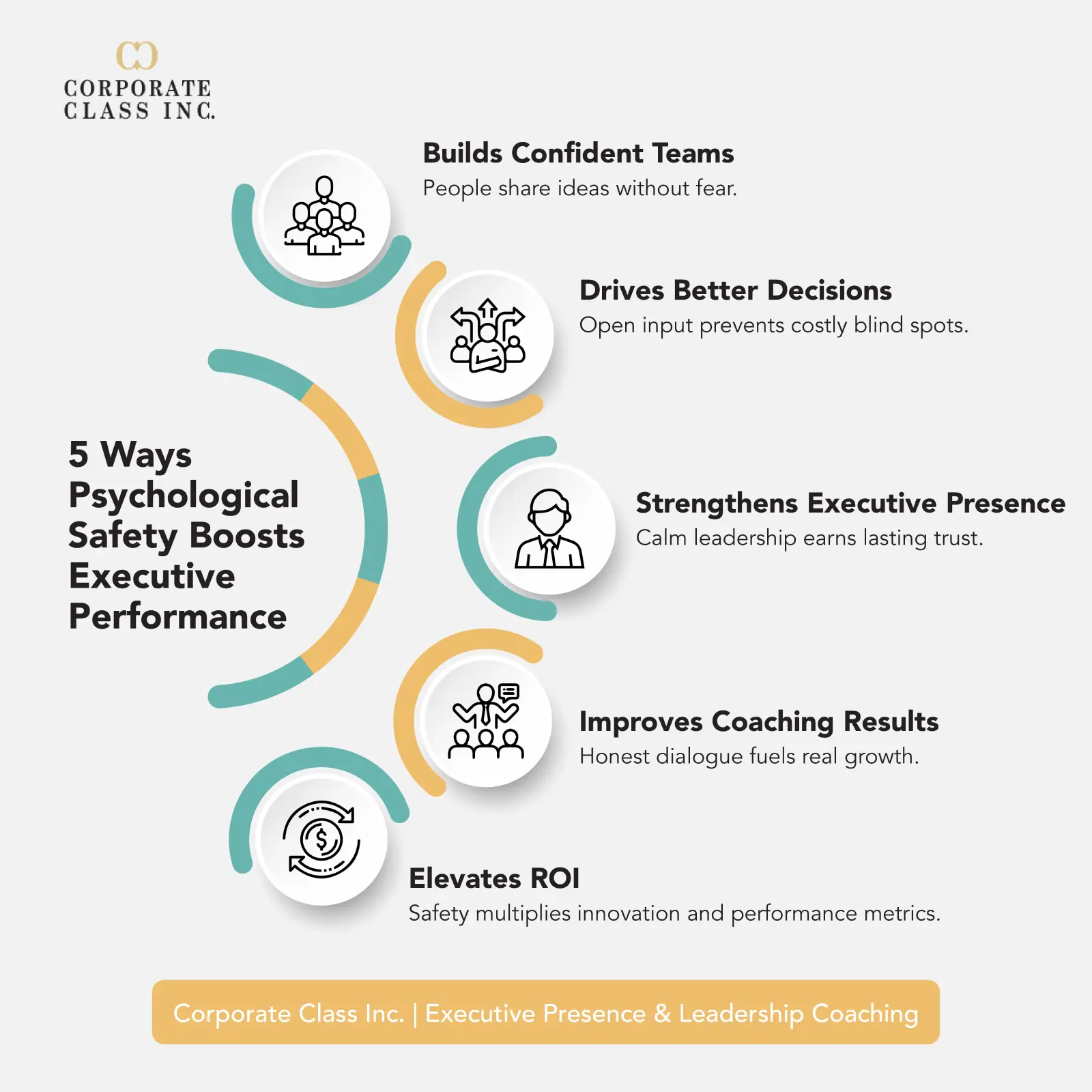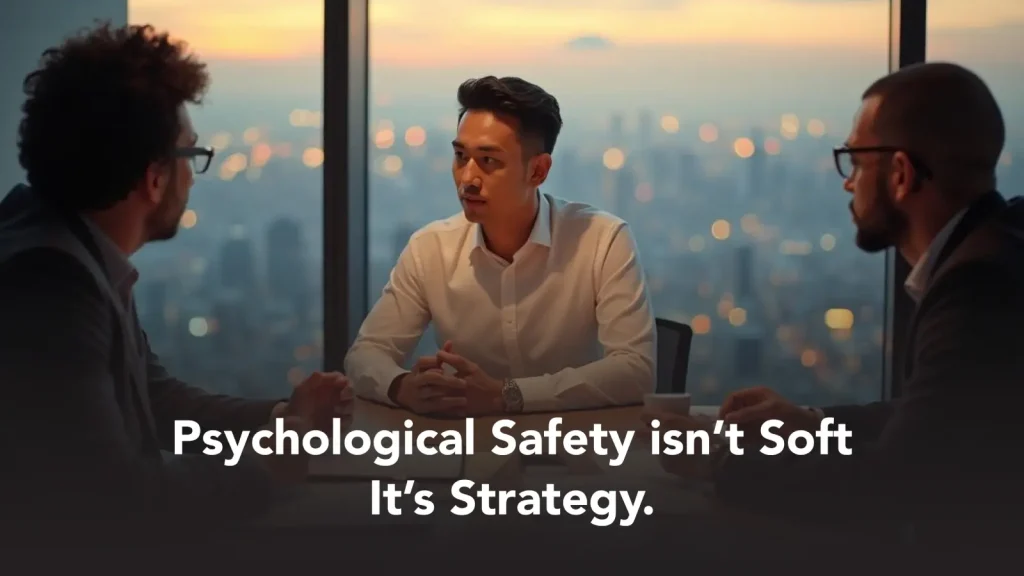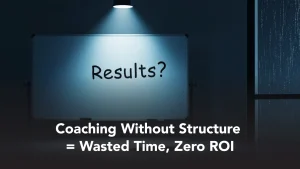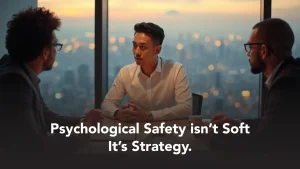Psychological safety defines the difference between teams that perform at standard levels and those that perform beyond expectations. For executives, it means creating an environment where accountability and innovation can coexist. Without it, decision-making slows, communication breaks down, and confidence erodes at every level of leadership. This article explores how psychological safety impacts executive performance, leadership credibility, and ROI, while offering actionable strategies to create a culture where people think boldly and perform consistently.
Key Takeaways
- Psychological safety directly impacts leadership performance, retention, and innovation ROI.
- Executives who model openness and security improve team resilience and decision speed.
- Coaching and trust-building are measurable pathways to sustain long-term cultural strength.
Calculating the Business Cost of Leadership Without Psychological Safety
Ignoring psychological safety costs organizations more than they realize. The price shows up in reduced engagement, slower innovation cycles, and higher turnover. When leaders fail to establish safety, employees spend mental energy on protection instead of productivity. Teams start concealing mistakes, creativity fades, and performance metrics flatten.
Every unspoken idea represents a missed opportunity for growth, every withheld concern a potential crisis in disguise. When leaders dismiss the value of psychological safety, they unintentionally silence the feedback loops that drive improvement.
Executive decision-making also suffers. When teams hesitate to speak truth to authority, blind spots expand, and missteps go unchecked. In contrast, psychologically safe environments promote transparency, where challenges surface early enough to correct course. The outcome is higher trust, faster learning, and a measurable return on leadership confidence.
5 Ways Psychological Safety Boosts Executive Performance

Psychological safety is more than a leadership buzzword, it’s a competitive advantage. When executives cultivate an environment where people feel safe to speak, question, and even fail, performance rises across every level of the organization. Teams take smarter risks, communicate more openly, and make decisions grounded in trust rather than fear.
1. Builds Confident Teams
When leaders encourage input without judgment, people stop holding back. They share ideas, raise concerns, and challenge assumptions, key behaviors of high-performing teams. Confidence grows when team members know their voice matters, leading to stronger collaboration and faster problem-solving.
2. Drives Better Decisions
Diverse perspectives reveal blind spots. When psychological safety is present, leaders gain access to the full intelligence of their teams. Decisions become sharper, more balanced, and less prone to costly oversights because everyone feels free to contribute insight and expertise.
3. Strengthens Executive Presence
A calm, composed leader who listens openly earns deeper trust. Psychological safety reinforces executive presence by replacing reactive leadership with grounded confidence. The ability to handle tension or mistakes with steadiness signals maturity and builds credibility within the organization.
3. Improves Coaching Results
Coaching thrives on honesty. When team members feel safe to be vulnerable, feedback becomes a two-way exchange instead of a one-sided performance review. Executives who create this space accelerate development, fostering accountability and meaningful growth among their teams.
4. Elevates ROI
Psychological safety drives innovation, and innovation drives results. When fear of failure disappears, creativity and performance metrics rise. The financial impact is clear: engaged, supported employees produce stronger outcomes, more loyalty, and greater long-term value for the organization.
Building psychological safety isn’t about making people comfortable, it’s about making them courageous. For executives, that courage translates into stronger teams, smarter strategies, and a culture that consistently performs at its best.
Improving Executive Decision-Making Under Pressure Through Psychological Safety
High-stakes leadership moments reveal the strength of a team’s psychological safety. When stress levels rise, safety determines whether people freeze, retreat, or contribute ideas that move the business forward. Executives who cultivate safety under pressure unlock faster, smarter collaboration that turns crisis into clarity.
Decision quality improves when leaders make space for candid dialogue. Teams that feel safe to challenge assumptions or admit uncertainty produce richer insights. Instead of one perspective dominating the conversation, the best solution emerges from shared evaluation.
- Encourage dissent: Constructive disagreement fuels innovation and prevents groupthink. When leaders reward thoughtful debate, creativity expands.
- Acknowledge uncertainty: Admitting unknowns humanizes leadership and strengthens trust. It signals confidence in collective intelligence.
- Respond, don’t react: Calm responses to failure maintain equilibrium and build psychological strength across the team.
- Protect contributors: When people take risks in discussions, recognition should follow, not reprimand. That behavior sets a tone for future openness.
These principles convert fear-driven silence into productive honesty, transforming executive meetings into performance laboratories. The more consistently they’re practiced, the greater the organizational resilience.
Building Executive Presence and Influence by Cultivating Safety
Executive presence thrives in environments where people feel secure expressing ideas and concerns. Presence is not just about posture or tone, it is about the ability to create calm confidence in others. When leaders cultivate psychological safety, they command respect through reliability, not authority.
Teams gravitate toward leaders who make them feel seen and supported. The ability to listen actively, remain composed, and acknowledge input builds credibility faster than any formal title. This credibility becomes the core of influence, allowing leaders to move initiatives forward through alignment rather than pressure.
When psychological safety becomes part of a leader’s style, engagement naturally rises. Employees trust direction when they trust intention. The executive who can balance high expectations with high empathy creates an atmosphere where accountability feels empowering instead of intimidating. Over time, this builds cultural loyalty that no incentive program can replicate.
Correcting Common Coaching Missteps Around Emotional and Psychological Safety
Many coaching programs address performance metrics without addressing emotional context. The mistake lies in treating coaching as instruction instead of partnership. True leadership development requires a psychologically safe environment where vulnerability fuels growth, not fear.
Coaches sometimes focus on technical skill at the expense of emotional resilience. When feedback feels judgmental instead of developmental, it triggers defensiveness rather than self-reflection. The result is surface-level improvement without lasting behavioral change.
A more effective approach balances accountability with empathy. Coaches who demonstrate curiosity instead of critique invite deeper conversations about motivation, obstacles, and pressure points. That awareness helps leaders internalize lessons instead of memorizing them. Psychological safety transforms coaching from a corrective exercise into a collaborative performance system.
Using Trust and High Performance Without Compromising Standards
Psychological safety does not mean lowering standards, it means achieving excellence through confidence, not fear. The strongest cultures hold both safety and accountability in balance. When leaders clarify expectations and reinforce consistency, high performance becomes a shared pursuit rather than a top-down demand.
When trust is high, people push harder and think bolder. They take ownership of outcomes because they believe effort will be recognized fairly. This dynamic builds commitment that outlasts incentives, creating teams that outperform under any condition.
- Set transparent expectations: Clarity builds fairness and reduces anxiety about performance criteria.
- Measure through collaboration: Involve team members in defining metrics to promote shared responsibility.
- Reward improvement: Recognition sustains motivation and proves that growth is valued as much as results.
- Address failure with perspective: Treat setbacks as data, not disasters, encouraging analysis instead of avoidance.
High-performing leaders understand that accountability without safety breeds burnout. Safety without accountability breeds complacency. The intersection of both creates excellence that lasts.
FAQ
- How does psychological safety affect executive performance?
Psychological safety directly influences confidence and agility under pressure. Leaders who feel safe to express uncertainty or seek input make stronger, faster decisions. The outcome is improved accuracy, innovation, and overall business ROI. - Can psychological safety be measured in leadership development?
Yes. It can be tracked through engagement surveys, feedback frequency, and error-reporting openness. When those metrics improve, productivity, retention, and collaboration improve alongside them. - How does psychological safety connect with organizational culture?
It shapes culture by redefining how people interact and share information. A safe culture encourages upward communication, builds loyalty, and reduces politics, creating a transparent, high-performing environment.
Sustaining Growth Through Psychological Safety
Building psychological safety is not a soft skill, it is a strategic leadership asset. When you invest in it, decision-making sharpens, innovation flows, and accountability strengthens across every level of your organization. Teams that feel secure take smarter risks, communicate faster, and perform longer under pressure. Begin by modeling safety in your leadership behavior, and you will transform performance culture from the top down.





